Annual Report 2023
Red Cross Red Crescent Climate Centre

PREFACE
Looking back on 2023, we see a year in which – to the acute dismay of all – war came, once again, to dominate the international agenda.
To be sure, both before and after the dramatic escalation of the conflict in the Middle East on 7 October, there was no shortage of climate headlines. Above all, and from the vantage point of early 2024, we can say with certainty that last year was the warmest on record “by a huge margin”, in the WMO’s words, through a combination of climate change and El Niño.
By August, for example, countries across the IFRC Asia Pacific region were reeling from multiple disasters. Eight DREF allocations to National Societies for climate-related events had been issued by this point: three for dengue to Bangladesh, Nepal and Sri Lanka; three for floods to Mongolia, Pakistan, and Afghanistan; one for a tropical cyclone to Bangladesh; and one for a cold snap to Mongolia.
Climate change turned what would have been manageable dry conditions in the Horn of Africa into what the US Drought Monitor classified as “exceptional drought”, the most severe of its five levels, according to our colleagues in the World Weather Attribution group. Yet at this writing, the IFRC’s related emergency appeal for nearly a quarter of a billion Swiss francs was woefully underfunded.
In a stark warning just ahead of the UN climate talks in Dubai, our Secretary General, Jagan Chapagain, who was on the COP28 advisory committee, re-emphasized that the climate and environmental crisis is a “hazard multiplier”, exacerbating almost every humanitarian disaster the IFRC faces.
There were also some morsels of good news: a measurable success of the COP meeting itself was the establishment of a formal fund for the thorny issue of loss and damage – even if, so to speak, it is for the moment an underfunded fund.
In a significant publishing event for us, the IFRC and the Climate Centre together issued a comprehensive new guide to climate-smart programming and humanitarian operations for National Societies, focusing on the use of climate-related information to reduce risk and human vulnerability.
It has also been a year of change for the Climate Centre itself, which towards the end of 2023 chose the Delhi-based adaptation expert, Aditya Bahadur, as its new director; he was taking up the post on 1 May. We wish him well in the new challenges he faces, in a world where issues in the climate sector become more coherent even as overall global complexity increases.
by Yolanda Kakabadse, Chair, and Acting Director Julie Arrighi
At right: Cyclone Freddy, Mozambique, February–March 2023. (CVM)
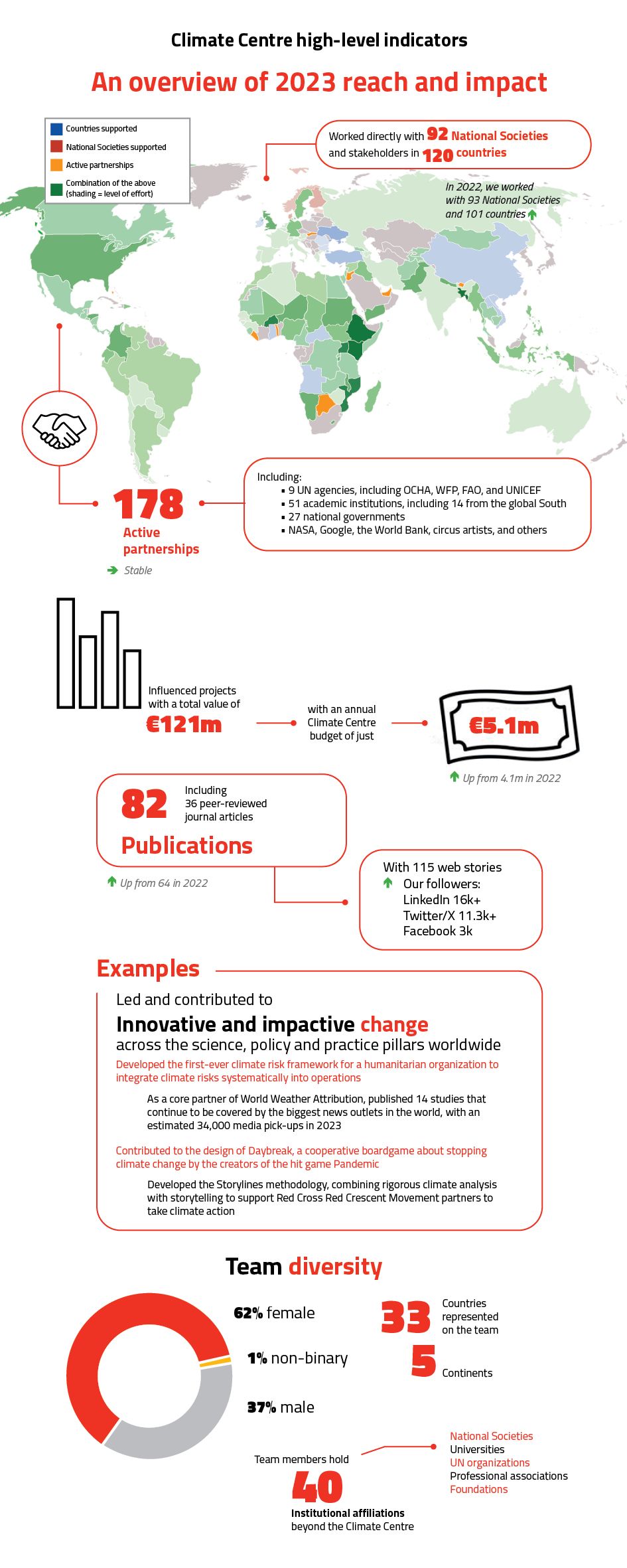
Climate Centre high-level indicators: 2023 reach and impact
Climate Centre high-level indicators: 2023 reach and impact
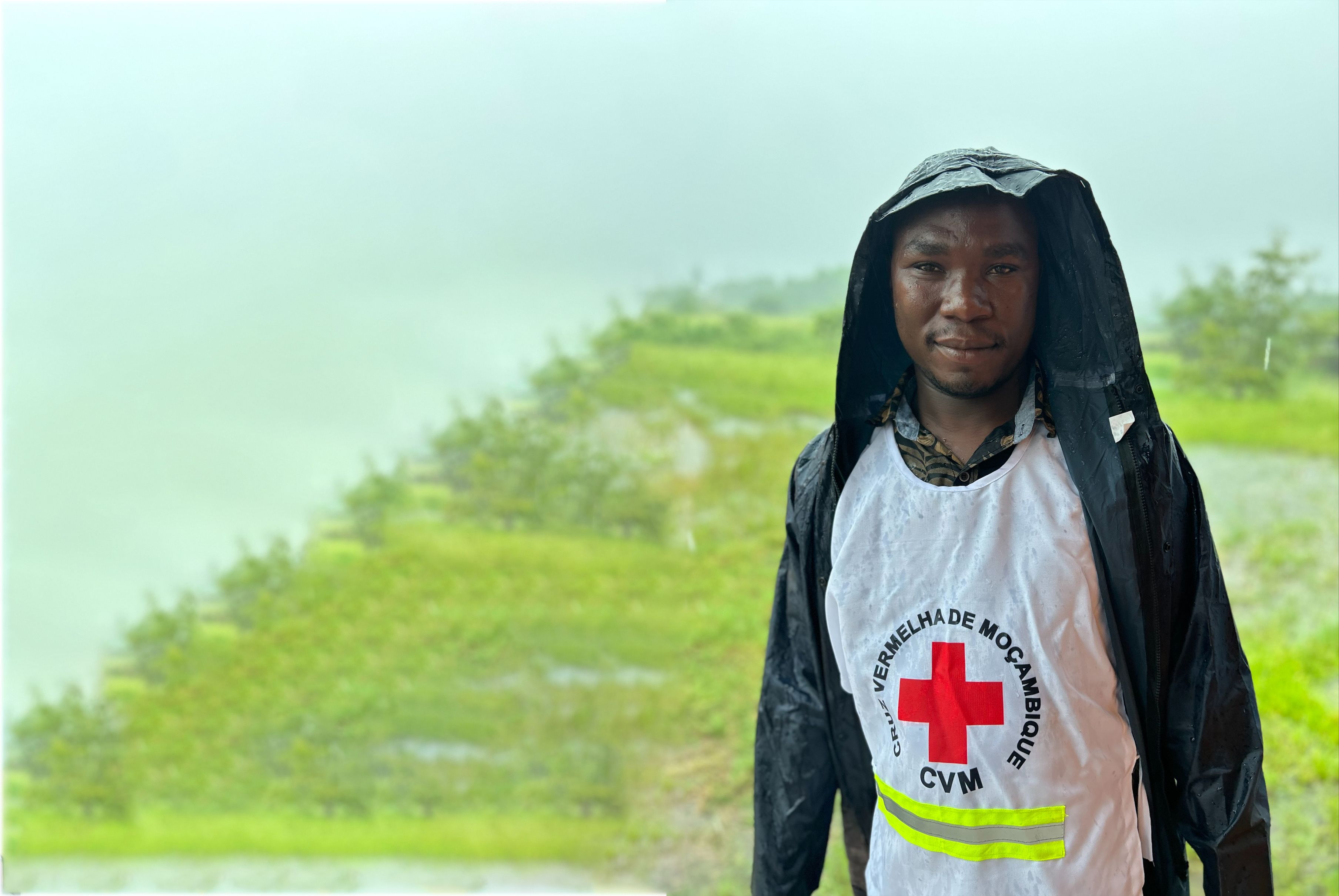
Policy
‘When we talk about hunger, it is the most undignified suffering of humanity, and in the case of compound crises, climate change adds tremendous pressure on people’
– Xavier Castellanos, IFRC Under Secretary General
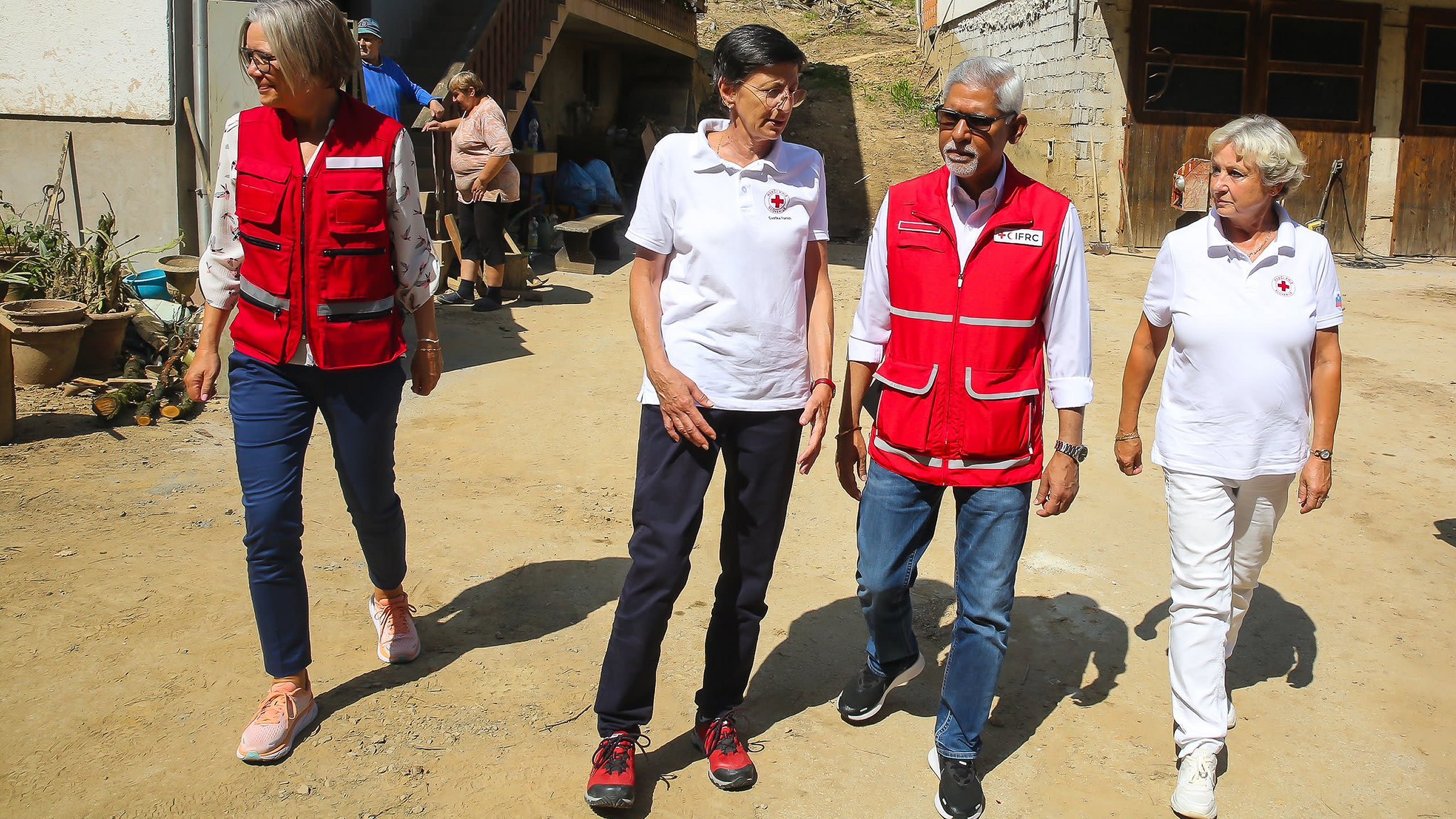
The Climate Centre has been supporting three main strands of policy in 2023: local and thematic work linked to National Societies, integrating policy across different thematic focal areas and regions, and contributing to global dialogue.
We collaborated with the IFRC and ICRC on integrating climate risks into humanitarian work, and in July we launched a new IFRC guide on climate-smart programmes and humanitarian operations.
In 2023 we also piloted a new climate action journey with the National Societies of Malawi, Nigeria and Pakistan, setting out strategic steps towards scaling up locally led adaptation, to be officially launched in full in 2024.
Other highlights included supporting a wide range of National Societies in effective advocacy. We supported the IFRC retreat centred on disaster risk reduction for National Societies in Africa as part of a fellowship programme, engaging with stakeholders on climate policy and translating it into practice at the national level.
We used creative approaches to communicate climate messages and piloted a new way of engaging at the innovation summit in Nairobi with Cartoons Anonymous to facilitate complex dialogue around climate.
To assist policy discourse, we also facilitated a Red Cross Red Crescent Movement forum in close collaboration with the IFRC, ICRC, National Societies and reference centres, the Anticipation Hub and REAP, focused on humanitarian engagement with loss and damage.
Regular virtual meetings linked different actors in the space and provided a forum for National Societies to engage around global policy questions, while linking this to their national and regional work. We also supported specific policy events at the request of National Societies to bring a climate lens to the discourse.
We actively promoted linkages between lived experience and policy work. On the regional level, for example, we engaged in policy dialogues featuring key messages from the ENBEL project on climate and health with EU stakeholders, jointly facilitated the CHANCE network conference on climate and health in Botswana, and linked with the IFRC on policy messaging.
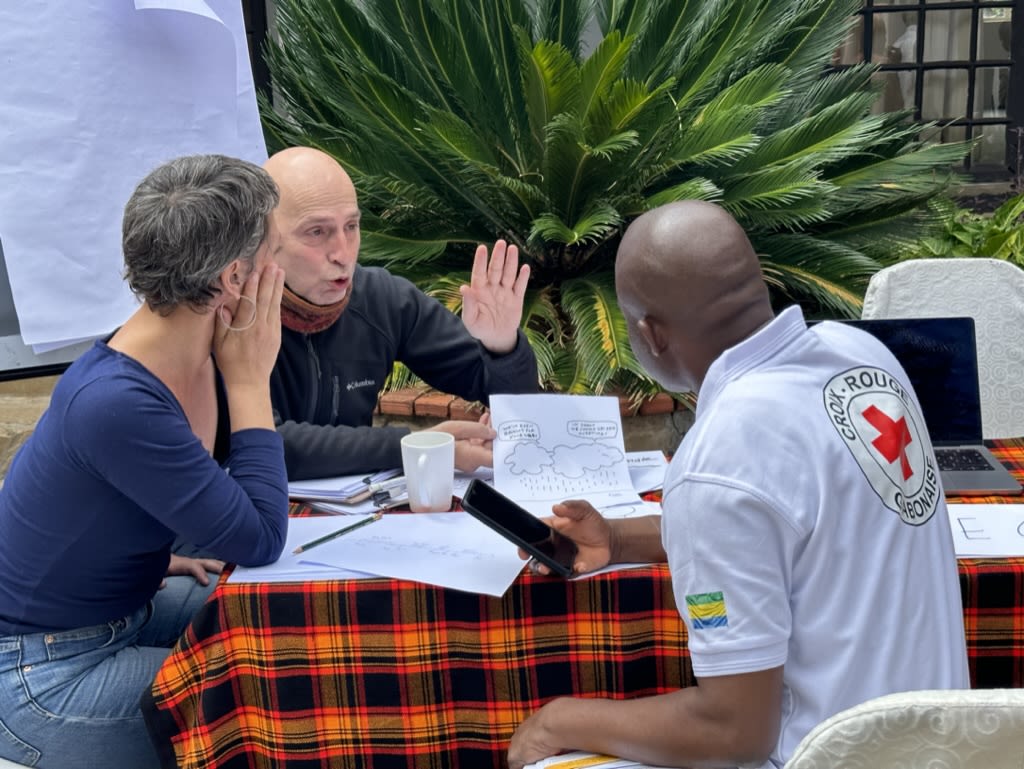
Cartoon artists facilitating a session with the Gabon Red Cross at an IFRC retreat in Kenya on risk reduction. (Climate Centre)
Cartoon artists facilitating a session with the Gabon Red Cross at an IFRC retreat in Kenya on risk reduction. (Climate Centre)
Last year we also embarked on an important regional project: Water at the Heart of Climate Action, exploring water and early warning in specific catchment areas. This combined insights from community experience with the global initiative on early warning for all. It aims to transcend disciplinary boundaries, and we collaborated on it with the National Societies of (alphabetically) Ethiopia, the Netherlands, Rwanda, South Sudan, Sudan and Uganda, as well as the IFRC, UNDRR and the WMO.
Our team contributed to the messaging for COP28 in Dubai, serving on two expert groups of the Executive Committee of the Warsaw International Mechanism for Loss and Damage.
Our technical advisers Florence Pichon, Sarah Gale and Manon Ebel authored a publication for the expert group for comprehensive risk management: Key findings related to loss and damage from the Working Group II report of the sixth IPCC assessment of the global climate, jointly published with the Zurich Flood Resilience Alliance, IIASA and Climate Analytics, endorsed by the technical experts themselves.
A second paper involving our former Acting Director Carina Bachofen and technical advisor Dorothy Henrich was also endorsed by the Warsaw International Mechanism: The role of early warning early action in minimizing loss and damage, co-authored with partners from REAP and Practical Action.
Interim Associate Director Bettina Koelle, serving on the WIM EXCom expert group on slow-onset events, was compiling a technical guide on desertification to be published in 2024.
The Climate Centre contributed to a range of UNFCCC events throughout the year, supporting dialogue and strong policy messaging across disciplines to protect the most vulnerable. This included a cartoon wall featuring a range of international artists for COP28 in Dubai, side-events at the UN climate talks, and support for National Societies in navigating negotiations.
With the IFRC we jointly facilitated a strong youth delegation at COP, bringing the voices of the Movement’s young to the global policy debate.
The Climate Centre also jointly hosted Development and Climate Days in Dubai, exploring adaptation, innovation and finance, and combining community perspectives with global policy.
D&C Days 2023 gathered nearly 300 grassroots representatives, political leaders, policy-makers, negotiators and researchers in dialogue about equity and accountability at the intersection of climate, adaptation and development.
Anticipatory action
‘There were 70 anticipatory action frameworks in place in 2022. These covered 7.6 million people worldwide’
– Anticipation Hub, launching Anticipatory Action in 2022: A Global Overview, published in April 2023
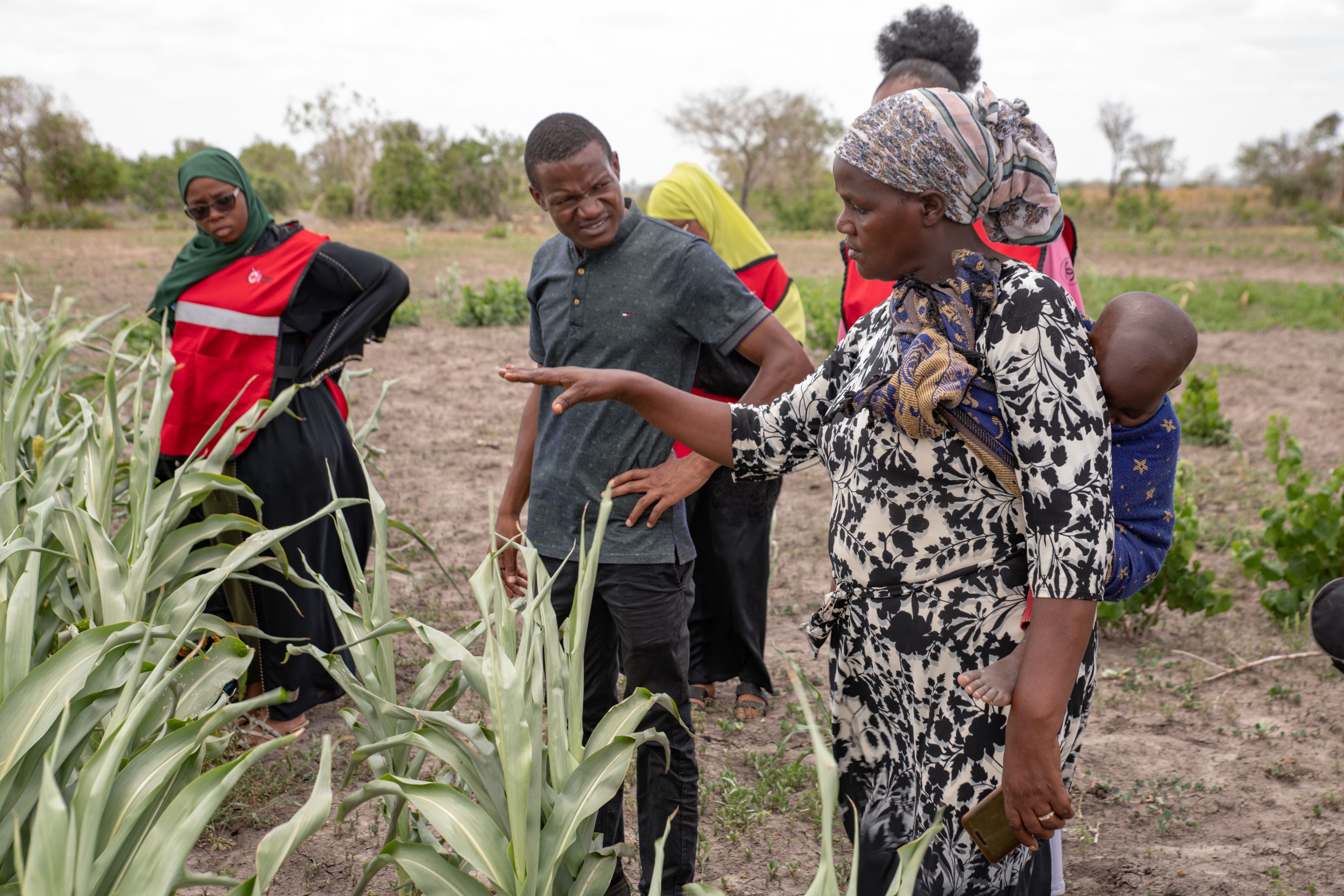

The tapestry-style artwork created by the Climate Centre’s Rebeka Ryvola for the 11th global dialogue platform in Berlin.
The tapestry-style artwork created by the Climate Centre’s Rebeka Ryvola for the 11th global dialogue platform in Berlin.
In partnership with the IFRC, we developed new online learning materials for National Societies, fulfilling a resolution to support the scaling up and operationalization of anticipatory action at the Movement’s Council of Delegates – the forum through which it agrees common approaches to global humanitarian issues.
The Climate Centre contributed to a global overview published by the Anticipation Hub, the first such report, taking stock of progress and showing that 70 anticipatory action frameworks have been implemented to date in 35 countries, covering 7.6 million people.
Also as part of the Hub, the Climate Centre contributed to the design of advocacy pieces on anticipatory action for COP28: special briefs were developed on epidemics and loss and damage.
The Climate Centre facilitated national dialogue platforms in (alphabetically) Bangladesh, Nepal, Pakistan and the Philippines, while at the regional level our team supported the Africa, Asia Pacific and Latin America dialogue platforms, organized through the Hub.
At the global dialogue platform in Berlin, we led on interactive and creative aspects, including an art work developed by our in-house artist Rebeka Ryvola.

The tapestry-style artwork created by the Climate Centre’s Rebeka Ryvola for the 11th global dialogue platform in Berlin.
We supported the final development of seven early action protocols and two simplified EAPs for drought, heatwaves, tropical storms, floods and population movement in Africa, Asia and Europe, and assisted WFP Uganda in creating frameworks for anticipatory action (similar to EAPs) for floods and drought.
With the arrival of El Niño, forecasts indicated many regions would experience impacts such as floods and droughts: EAPs were activated in Djibouti, Ecuador, Honduras, Kazakhstan, Kenya, Somalia, Uganda, Zambia and Zimbabwe.
Beyond Movement partners, we have supported the development of national and regional road maps on anticipatory action in Asia and Africa, and, with the Hub, the IGAD regional roadmap on anticipatory action.
With the IFRC and a group of National Societies, we joined the UN project Water at the Heart of Climate Action, mitigating the impacts of water-related risks and disasters and increasing resilience in Ethiopia, South Sudan, Sudan and Uganda; we have continued to provide technical support for the WMO’s early warning for all initiative.
The Climate Centre contributed to improving the evidence base for anticipatory action through our research and we published articles on loss and damage, anticipatory cash after floods, and general lessons from the Red Cross Red Crescent.
We joined UK- and Canadian-supported research in Madagascar, Malawi, Mozambique, South Sudan and Uganda to bridge programming across anticipatory action and adaptation timescales, in countries dealing with protracted crises and climate change simultaneously.
Attribution
‘People in the Horn of Africa are no strangers to drought, but this event stretched them past their ability to cope’
– Cheikh Kane, Climate Centre, World Weather Attribution study, April 2023
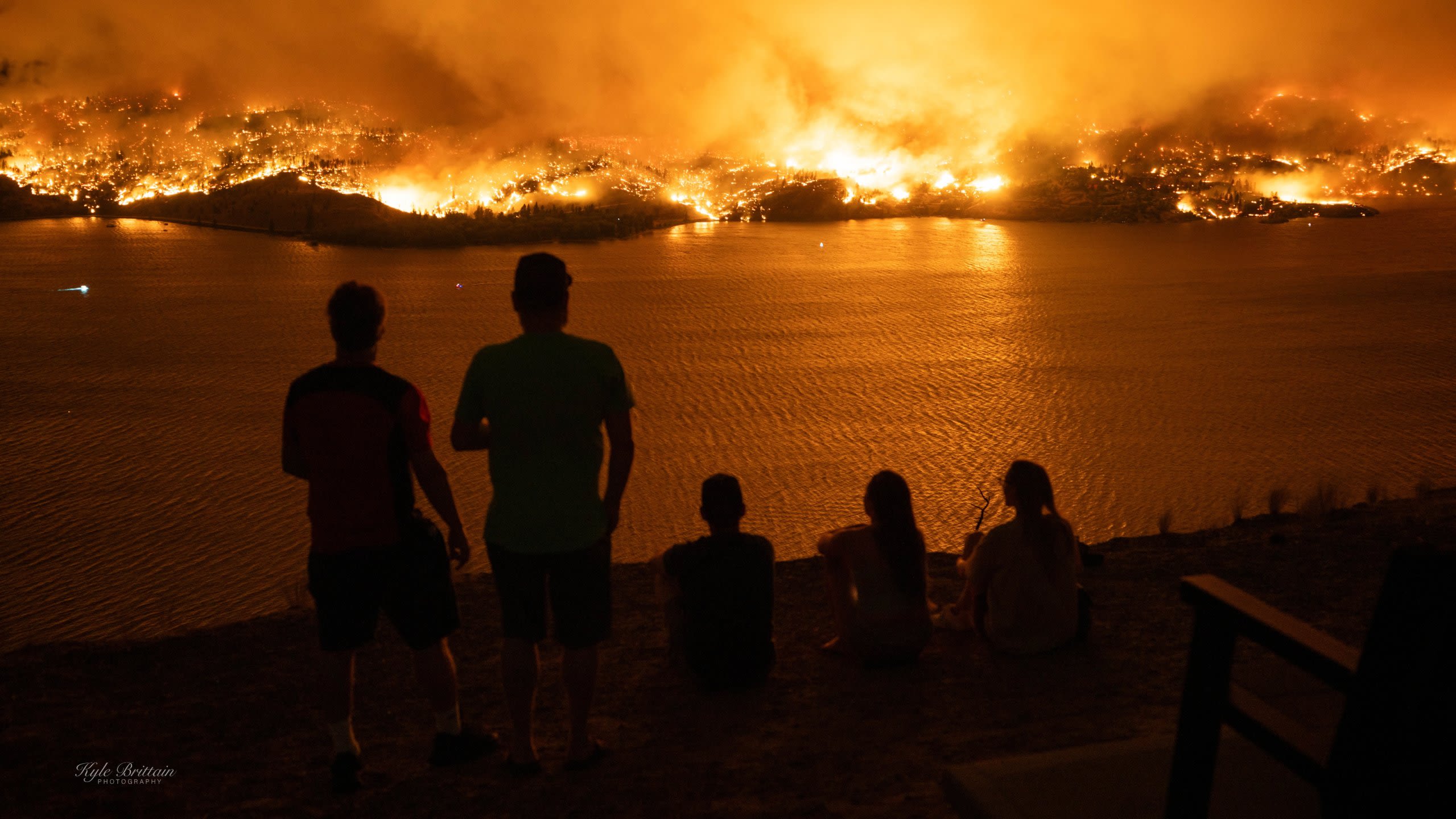
The World Weather Attribution group of which the Climate Centre is a part published 14 studies in 2023, which generated an estimated 34,000 media mentions. WWA continues to be covered by major global news outlets, with significant year-on-year increases in media coverage.
The Climate Centre maintains the methodology that guides decision-making on which events meet our thresholds for study, ensuring impact-based definition of events, analysing vulnerability and exposure, and interpreting findings for future adaptation and recovery.
In February, we looked at the drought affecting northern Argentina and southern Uruguay. Analysis of average precipitation and the effect of temperature on evapotranspiration found that climate change had not caused low rainfall but had increased the intensity and likelihood of high temperatures.
In March, we published a study on Cyclone Gabrielle which hit the north island of New Zealand. Analysis of the rainfall found a climate signal but we were unable to quantify it due to discrepancies between observations and climate models.
In April, we analysed the 2021–2022 drought impacting Ethiopia, Kenya and Somalia. Analysis of precipitation over the two rainy seasons, combined with evapotranspiration, found that climate change had made the event approximately 100 times more likely, pushing it into the “exceptional” category.
In May, we published three studies. The first focused on extreme heat over south-west Europe and North Africa. The second looked at the South Asian humid heatwave in April. Analyses of observed maximum daily temperatures found that climate change made the Mediterranean heat at least 100 times more likely and 2°C hotter, while the heat over South Asia was approximately 30 times more likely and 2°C hotter. In South-East Asia, the heatwave would have been virtually impossible without climate change and more than 2°C cooler.
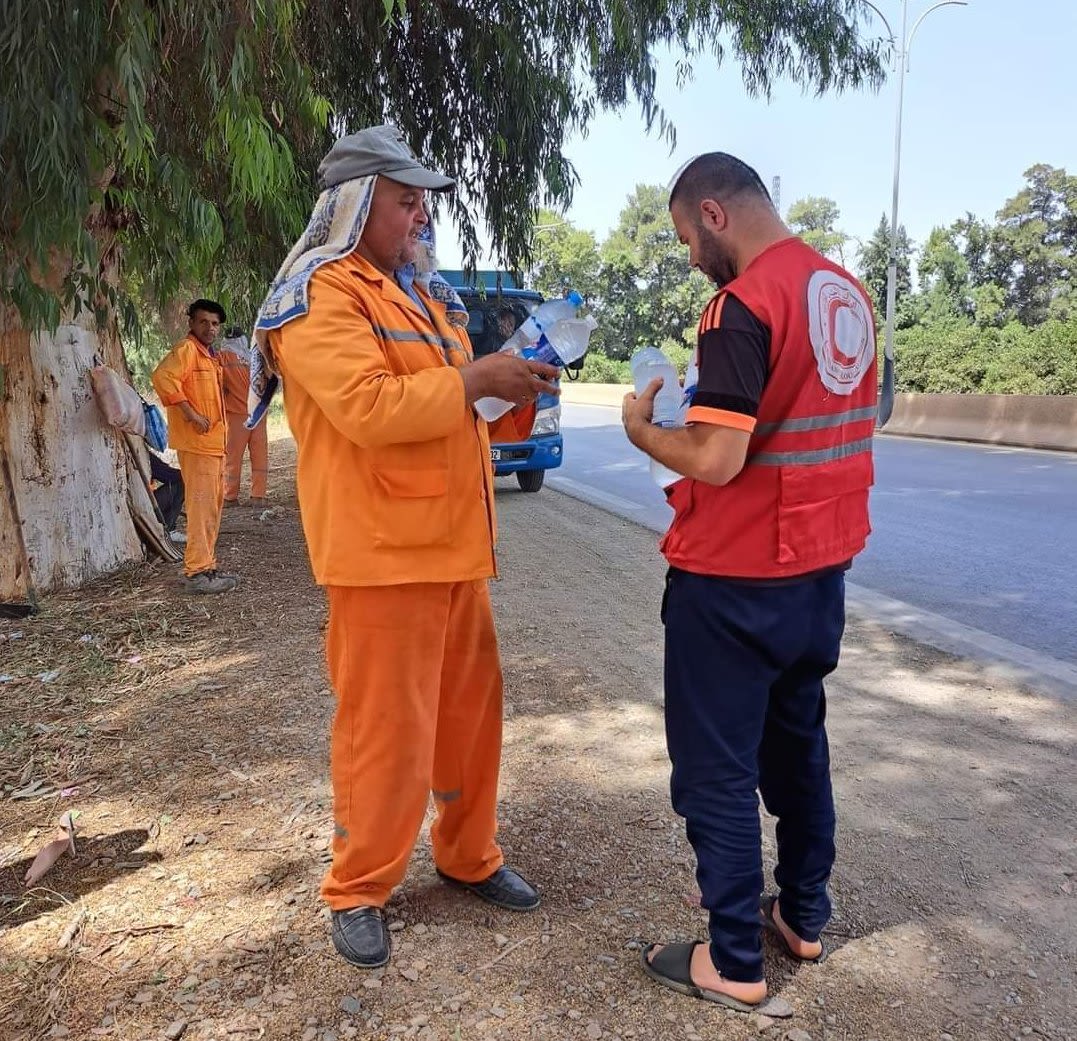
The Red Crescent in Algeria distributing drinking water to sanitation engineers and passers-by. North Africa saw even higher temperatures in the 2023 heatwave than countries on the other side of the Mediterranean intensifed by climate change. (Algerian Red Crescent)
The Red Crescent in Algeria distributing drinking water to sanitation engineers and passers-by. North Africa saw even higher temperatures in the 2023 heatwave than countries on the other side of the Mediterranean intensifed by climate change. (Algerian Red Crescent)
The other study in May looked at three consecutive episodes of heavy rainfall in northern Italy and found a limited role for climate change, with a decreasing number of low-pressure systems in the Mediterranean offsetting the expected increase in heavy rainfall.
In June, we looked at heavy rainfall in the Democratic Republic of the Congo and Rwanda. Scarcity of data prevented us from analysing the role of climate change but we highlighted the need for better observations, greater access to meteorological data, and more research to improve early warning and adaptation.
In July, we studied the extreme heat in North America, China and southern Europe and concluded it was respectively 2°C, 1°C, 2.5°C greater because of climate change.
An August study looked at the extreme fire-weather in eastern Canada and found that climate change made it 50 per cent more intense and seven times more likely in May to July, and 20 per cent more intense and twice as likely at its peak.
In September, torrential rainfall hit the Mediterranean region, including Bulgaria, Greece, Libya, Spain and Türkiye. Climate change made it up to 50 per cent more intense and as many as 50 times more likely, and this combined with vulnerability and exposure to create catastrophic impacts, including the dam failure in Libya that devastated the coastal city of Derna.
In October, we studied the early spring heat in Argentina, Bolivia, Brazil and Paraguay and concluded that it was made up to just over 4°C hotter and at least 100 times more likely.
In November, the three-year drought in Iran, Iraq and Syria was found to have been made 25 times more likely over Syria and Iraq, and 16 times more likely in Iran. In a 1.2°C cooler world without climate change, we concluded, this “extreme” drought would not have officially become a drought at all.
In Madagascar, the hottest October on record was found to have the fingerprint of anthropogenic climate change: a one-in-100-year event in today’s climate would become a one-in-five-year event in a world with 2°C of warming. The seven-day maximum and minimum temperatures were made 100 and 10 times more likely respectively and up to 2°C hotter in each case.
In December, we studied the torrential rainfall associated with the short rains in Ethiopia, Kenya, and Somalia, finding that climate change made it twice as intense, or four times as intense accounting for both climate change and a positive Indian Ocean Dipole.
Urban
‘Our commitment to collaborate is well timed with the historic agreement to operationalize the loss and damage fund
[at COP28]’
– Gino van Begin, ICLEI Secretary General,
on the new agreement with the IFRC
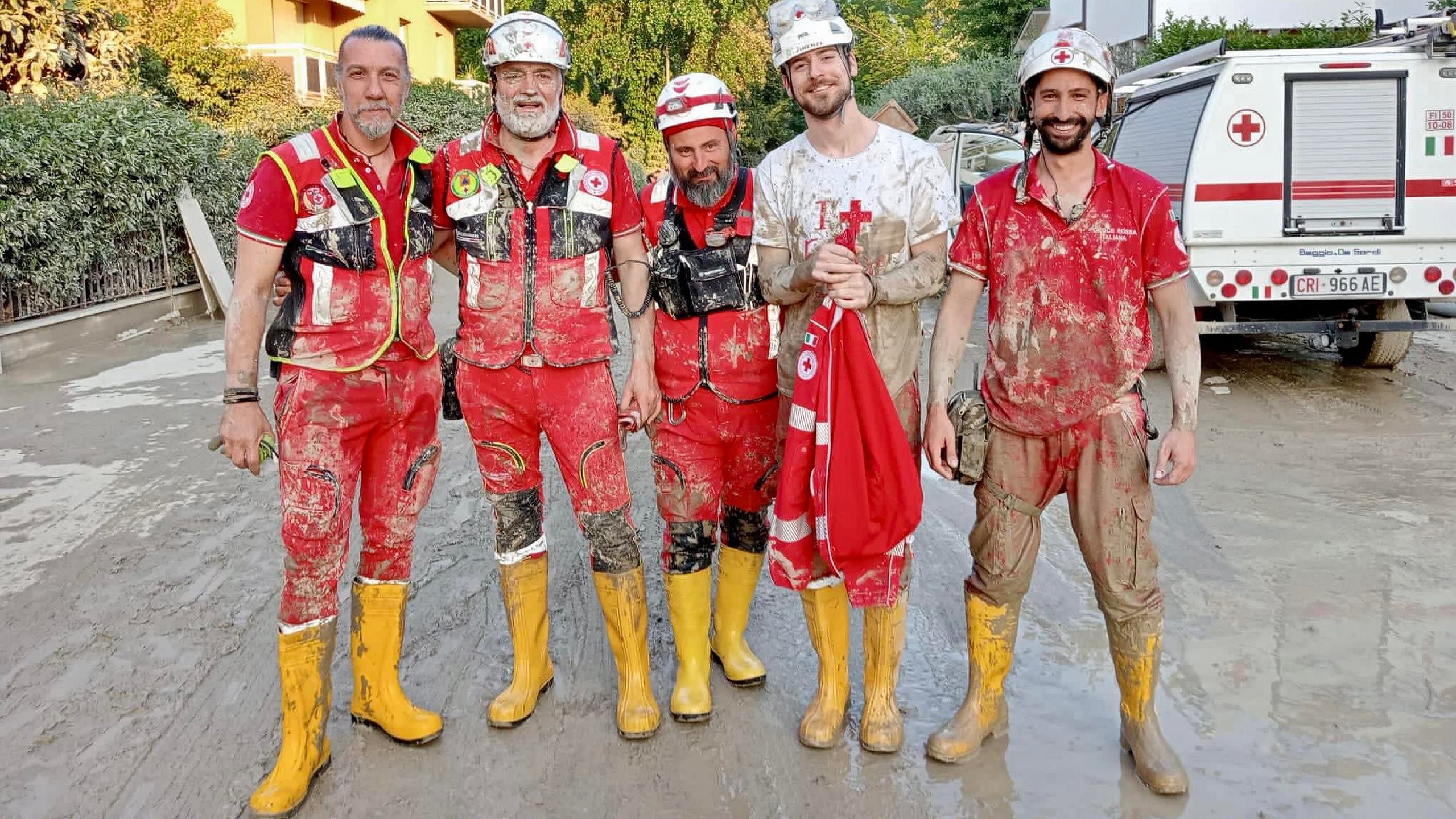
The Climate Centre completed the first urban climate fellowship programme, with support from Global Disaster Preparedness Center (GDPC) and the German Red Cross for over 25 staff and volunteers of National Societies.
We supported coalition building and risk assessments for target cities in (alphabetically) Bangladesh, Honduras, Indonesia and Tanzania, providing insights about which areas are most impacted by heat and coastal hazards.
As part of the learning agenda for CoCHAP (Coastal City Resilience and Extreme Heat Action Project), sharing and learning days were organized in November for National Societies, the IFRC secretariat and the Climate Centre.
The CASCADE project (Cascading Climate and Health Risks in African Cities) was launched with a mission to advance the understanding of critical urban health challenges faced by African cities; we are partnering with Ghana, Chinhoyi, Makerere and Witwatersrand universities, the African Population and Health Research Center, and START International.
The Climate Centre supported the Nepal Red Cross Society to publish and distribute to in-country stakeholders a heat action plan for the city of Nepalgunj, and we coordinated with the National Society and the IFRC to leverage resources for scaling up action on heat countrywide.

Libyan Red Crescent teams were the first on the ground evacuating people and providing first aid and search and rescue after Storm Daniel made landfall, triggering a “catastrophic and unprecedented” flood disaster. (Libyan Red Crescent)
Libyan Red Crescent teams were the first on the ground evacuating people and providing first aid and search and rescue after Storm Daniel made landfall, triggering a “catastrophic and unprecedented” flood disaster. (Libyan Red Crescent)
In a bid to advance urban action in the Asia Pacific region, the team helped with the drafting of an MoU for the IFRC and local governments, including plans for accelerating the 2030 initiative to make cities more resilient and the Asia Pacific urban hub.
With the IFRC we held our second annual Heat Action Day on 2 June, with the National Societies raising awareness of simple actions to reduce risks through social media including the Austrian, Jamaican and Rwanda Red Cross.
In addition, the Bangladesh Red Crescent staged flashmobs, distributed drinking water, and shared information; the Hellenic Red Cross held clinics with nurses, social workers and volunteers from the health and youth sectors; and the Indian Red Cross distributed drinking water to pedestrians and the general public as well as a flashmob.
The Prudence Foundation and the IFRC through the Climate Centre announced a new partnership to explore the health impacts of air pollution, extreme heat and humidity, intended to identify important gaps in the literature and culminate in an action plan to address the health impacts in a chosen Asian city.
On Day 1 of COP28, the IFRC formalized a cooperation agreement with Climate Centre partners ICLEI – the 2,500-strong global network of local and regional governments working for sustainable urban development in at least 125 countries. It was signed by Under Secretary General Xavier Castellanos and Gino van Begin, ICLEI Secretary General, concretizing “an already strong relationship”.
We also provided ongoing support to the Exhaustion project, especially in the development of its visualizations on climate change, air pollution and adaptation, and we supported IFRC communications on heat-related messaging and communication on heatwaves.
Supported by Canada, we completed scoping for the WHO on a study of indoor heat-health issues, including lessons from places where indoor interventions have been developed and operationalized, and we promoted the results of 15 small grants carried out in 13 low- and middle-income countries in coordination with the GDPC.
Julie Arrighi sat on the management committee of the Global Heat Health Information Network hosted by the WMO-WHO joint office in Geneva.
Social protection
‘Climate finance supporting social protection is not only a moral imperative but also a strategic approach’
– Sayanti Sengupta and Sajanika Sivanu, Climate Centre
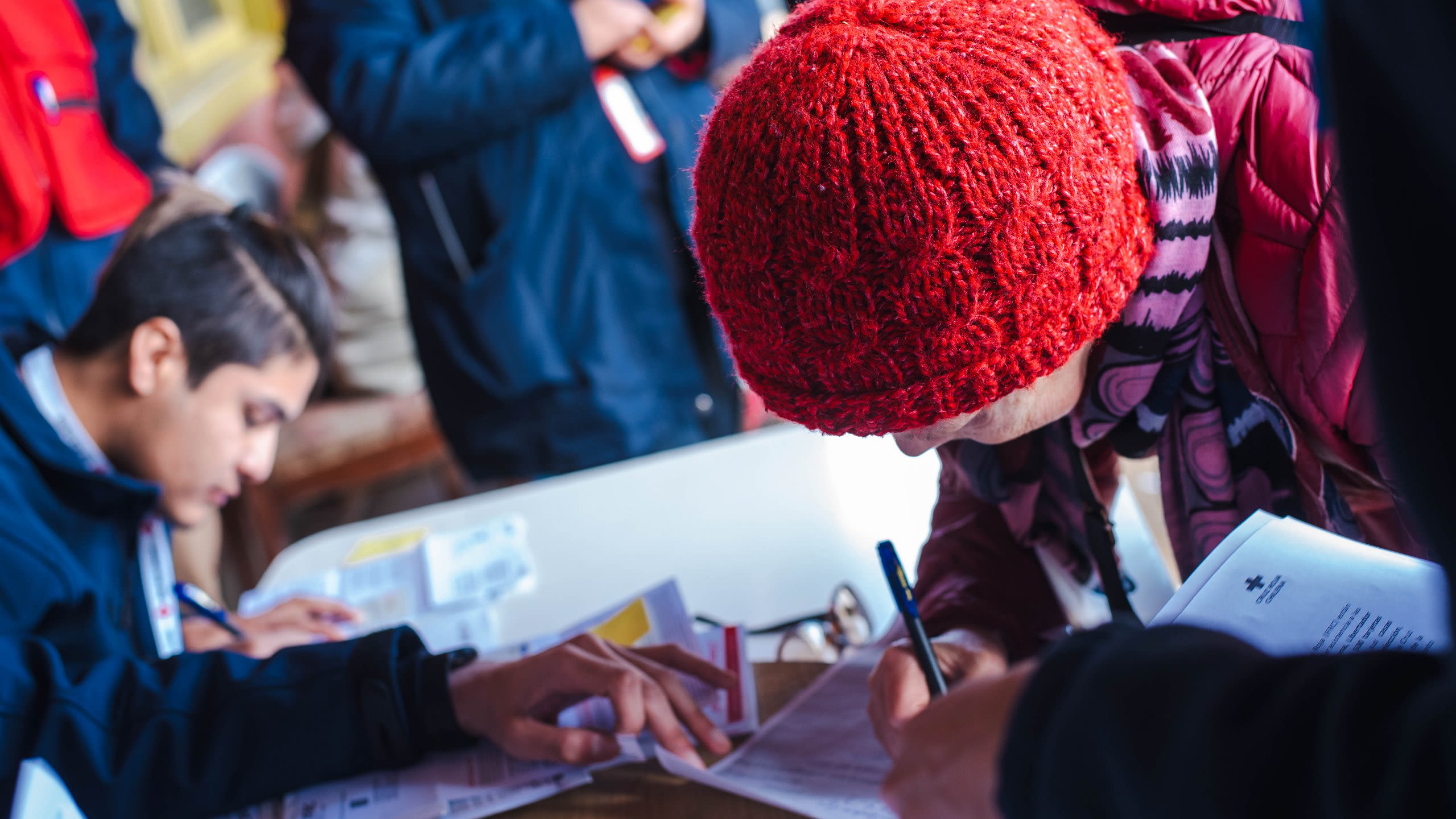

The Bombali branch of the Sierra Leone Red Cross Society rescuing three women trapped in a mudslide in the northern city of Makeni, triggered by intense rainfall. Strengthening Sierra Leone’s social protection system for addressing climate risks is a key priority among government and external stakeholders. (SLRCS)
The Bombali branch of the Sierra Leone Red Cross Society rescuing three women trapped in a mudslide in the northern city of Makeni, triggered by intense rainfall. Strengthening Sierra Leone’s social protection system for addressing climate risks is a key priority among government and external stakeholders. (SLRCS)
In 2023 the social protection team designed an intervention which would address the twin objectives of reducing poverty and environmental conservation in Colombia’s “arc of deforestation”. Building on past experience, a cash strategy and other measures were proposed that would also protect environmental resources and incomes.
In Nigeria, we developed triggers for river flooding, incorporating them into an early action protocol that successfully delivered unconditional cash assistance to nearly 5,000 vulnerable beneficiaries. They were subsequently integrated into a national database on rapid response, part of the social security register, and are expected to be used to scale up similar operations in the future.
We began feasibility studies for anticipatory action in (alphabetically) the Cook Islands, the Marshall Islands, Niue, Palau, and Tuvalu, conducting stakeholder consultations and field visits and identifying the potential linkages between anticipatory action and existing social protection systems.
The UK Met Office awarded us funding under a project for climate resilience through social protection in Burkina Faso and Mauritania by promoting weather and climate information services among social protection and climate actors.
In November, we jointly hosted a COP28 side-event in partnership with UNICEF, the World Bank and the German government on exploring adaptive social protection to respond to loss and damage for children and other vulnerable groups. Doris Mwikali, our youth advisory board member, was one of the panellists and underscored the urgent need for greater inclusion of youth in climate and social protection agendas.

The Bombali branch of the Sierra Leone Red Cross Society rescuing three women trapped in a mudslide in the northern city of Makeni, triggered by intense rainfall. Strengthening Sierra Leone’s social protection system for addressing climate risks is a key priority among government and external stakeholders. (SLRCS)
With the support of another youth advisory group member, Adnan Khan, from the Pakistan Red Crescent, we conducted a survey of 120 young people to identify climate impacts on employment opportunities for young Pakistanis. We looked at how climate risks and hazards are reshaping labour markets and traditional openings for young people and identified a role for social protection in supporting them in navigating these changes.
Two new briefs were published on the role of universal health coverage as a pillar for social protection and synergies in social protection and water, sanitation, and hygiene.
We have been leading an informal working group on social protection to connect National Societies working at the intersection of social protection and climate. Two meetings were held in 2023, bringing together several societies, including Partner National Societies, who shared their experience on how they are supporting and engaging with their country’s national systems on social protection.
During the global dialogue platform on anticipatory action in Berlin, we facilitated a hybrid workshop and piloted a role-play game in which participants imagine a country affected by real extreme events and are asked to protect people by taking early actions through social protection.
This workshop generated insights into how the different components of social protection function, and the opportunities and challenges of integrating social protection and anticipatory action.
Additionally, we have been jointly chairing the ILO’s working group on climate change and social protection, organizing meetings and expert panels to foster collaboration with partners beyond the Movement, and engaging in knowledge sharing and other activities with UN agencies, national governments and the academia.
Climate and conflict
‘We have seen some progress as we no longer need to make the case that people in conflict need support to adapt to
a changing climate’
– Catherine-Lune Grayson, ICRC Head of Policy, Amir Khouzam, ICRC Policy Adviser

Last year’s UN climate talks in Dubai saw a declaration on climate relief, recovery and peace developed by the COP28 presidency in partnership with a core group of countries and agencies including the ICRC and the IFRC – seen as a big step forward on climate action for people affected by conflict.
Our input at policy level included contributions to the new flagship ICRC report Weathering the Storm, with examples of successful adaptation in conflict-affected contexts.
We supported 25 ICRC delegations with capacity building, including e-learning, and we created a dedicated help desk to provide hands-on operational support. As part of this, we worked closely with the ICRC in Somalia to anticipate El Niño-related floods, enabling early actions including the distribution of 75,000 sandbags with the Somali Red Crescent.
Our support to the ICRC aided progress towards a global framework integrating climate risks into operations, bringing climate action into the core of the institution; we helped with the development of an adaptation catalogue and created a self-assessment tool for delegations.
Our partnership with the ICRC included new approaches to understanding climate risk: specifically, 20 new country profiles that use climate storylines were shared internally with the International Committee to help address uncertainty in adaptation planning; in 2024 we are publishing an external resource on this approach, exploring the storylines together with knowledge systems in 20 countries.
We engaged with other partners concerned with conflict to some degree across research, policy and practice. With Humanitarian OpenStreetMap, for example, we explored the use of OSM data in conflict contexts, focusing on supporting climate-smart recovery and reconstruction; in Georgia, we developed a comprehensive analysis of climate risks again using OSM data to feed into the operational planning of the ICRC delegation.

In April, with the assistance of the ICRC, nearly 1,000 former detainees held in relation to the conflict in Yemen were repatriated there and to Saudi Arabia – with Iraq and Syria, Yemen was a country where the ICRC last year said effects of climate change are being amplified by conflict. (ICRC)
We joined the US$ 30m CGIAR initiative on climate, conflict and migration, providing support focused on anticipatory action in conflict settings.
In July, we jointly launched REPRESA, the five-year international research effort led by Bristol, Eduardo Mondlane and Witwatersrand universities to improve understanding of cyclones in Southern Africa, including dimensions of conflict and displacement for long-term adaptation and anticipatory action.
Throughout the year, we continued to move forward with anticipatory action. With the Anticipation Hub, for example, in addition to ongoing work with the conflict working-group, we launched another on multiple risks jointly with ACAPS.
We also contributed to several reports, including an ICRC white paper on debt conversion for humanitarian and climate impacts and a UNDRR report on finance for disaster risk reduction – a contribution to the mid-term review of the Sendai Framework that includes evidence of some good progress.
Our peer-reviewed paper Beyond the forecast: knowledge gaps to anticipate disasters in armed conflict areas with high forced displacement was made available ahead of publication in early 2024.
Together with Mercy Corps, the Climate Centre hosted a round table on climate and security with other humanitarian organizations in The Hague, contributing to the report Overcoming the Fragility Barrier: Policy Solutions for Unlocking Climate Finance in Fragile States.
As part of our collaboration with the World Bank, we published a peer-reviewed analysis of the possible climate signal in temperature and rainfall for the periods 2020–2040 and 2040–2060 in Angola.
The head of the conflict team joined Princess Sophie of Liechtenstein, the president of its Red Cross society, and ICRC Director-General Robert Mardini to discuss the significance of climate action for conflict-affected populations; she as well participated in a SwissRE event with ICRC Africa Regional Director Patrick Youssef to discuss the role of the private sector.

In April, with the assistance of the ICRC, nearly 1,000 former detainees held in relation to the conflict in Yemen were repatriated there and to Saudi Arabia – with Iraq and Syria, Yemen was a country where the ICRC last year said effects of climate change are being amplified by conflict. (ICRC)
In April, with the assistance of the ICRC, nearly 1,000 former detainees held in relation to the conflict in Yemen were repatriated there and to Saudi Arabia – with Iraq and Syria, Yemen was a country where the ICRC last year said effects of climate change are being amplified by conflict. (ICRC)
Health
‘Once thought to be close to eradication, cholera is back, dehydrating and killing people within hours and ravaging communities across six continents’
– Petra Khoury, IFRC Director of Health and Care
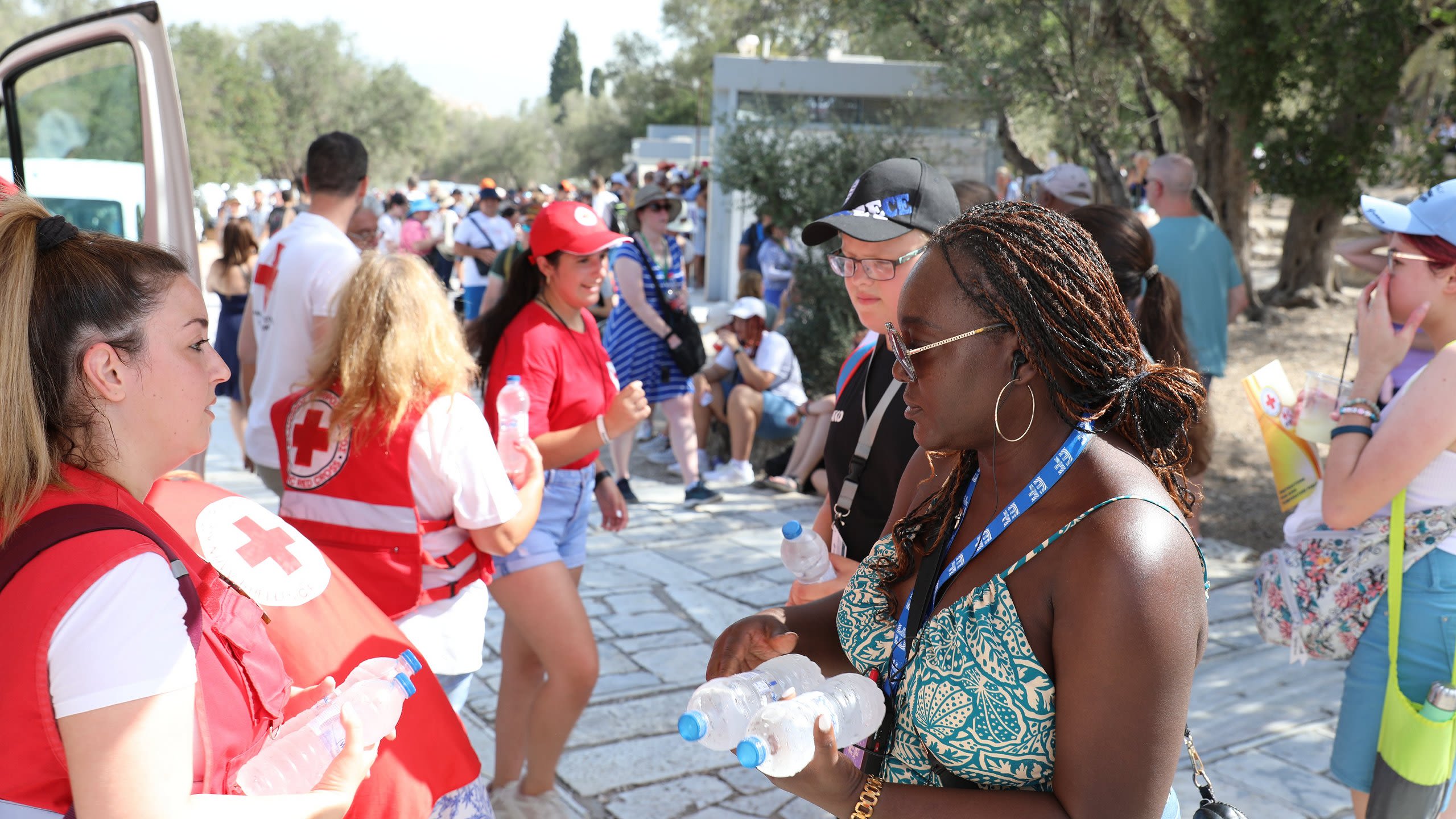
Our work on the impact of climate change on health continued to grow in 2023. The needs of National Societies remained a high priority, and we have continued to engage with them on their requirements for training and resources in the climate-health nexus.
We conducted a needs assessment of climate and health gaps with National Societies, work that will inform our support to them in the coming years, and we will continue to grow climate and health as a priority area for the Red Cross Red Crescent Movement.
The WHO and major donors in 2023 widely shared findings from our analysis on how little climate adaptation finance is reaching the health sector.
We have advanced the Movement’s knowledge on anticipatory action for climate-sensitive infectious diseases, focusing on Latin America and the Caribbean and East Africa.
In collaboration with MSF and the ICRC, we developed seasonal emergency calendars to display annual patterns of climate and hydrometeorological hazards and epidemiological trends in 20 different countries.
For COP28, we published a two-page summary of triggers developed by the anticipatory action and health working group we chair jointly with the IFRC, the German Red Cross, MSF and UNOCHA.
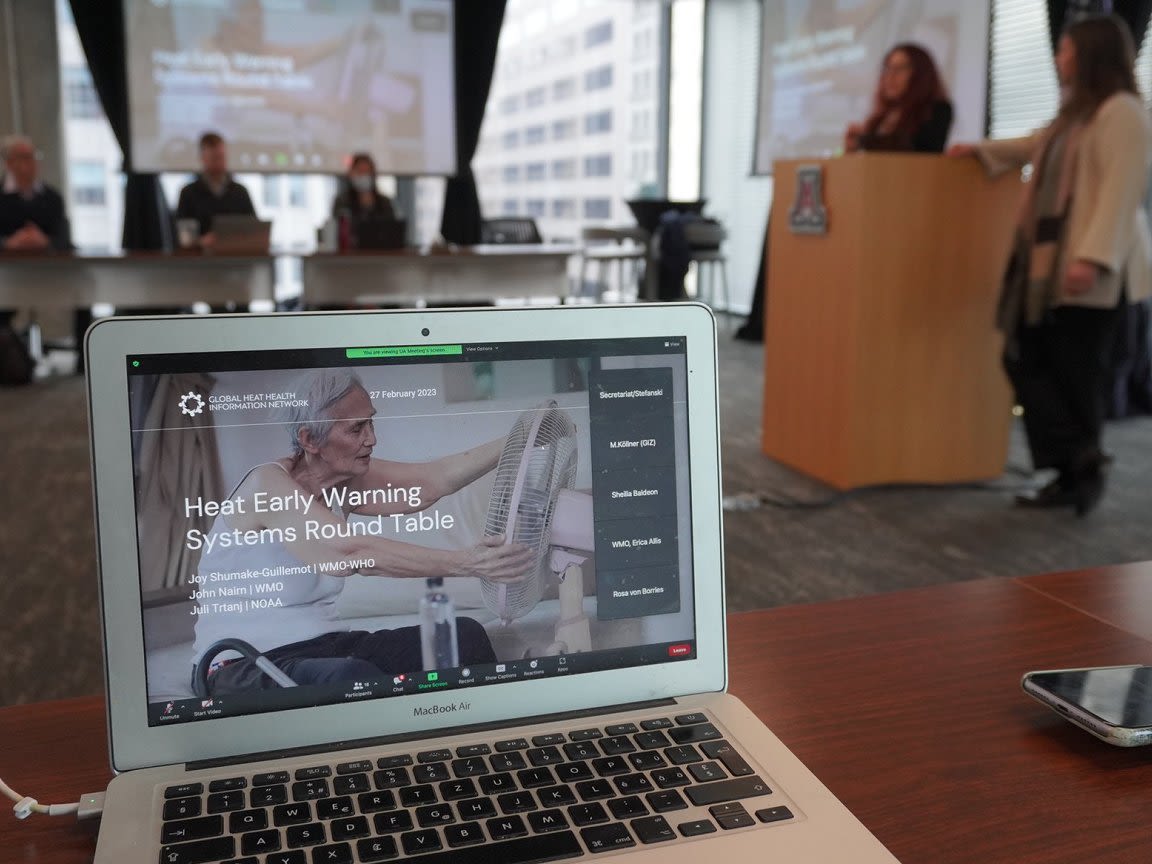
The Climate Centre represented the Red Cross Red Crescent at the first in-person meeting of the Global Heat Health Information Network since the onset of the Covid pandemic. (GHHIN)
The Climate Centre represented the Red Cross Red Crescent at the first in-person meeting of the Global Heat Health Information Network since the onset of the Covid pandemic. (GHHIN)
Our work on early warning systems for infectious diseases has expanded. We continue to work with the IDAlert Consortium focusing on the EU; we’re also partners in the IDExtremes project funded by Wellcome and led by the Barcelona Supercomputing Center that will develop an open-source tool to assess the probability of outbreaks of infectious diseases using hydrometeorological indicators.
We assessed risks of climate change and infectious disease in Cambodia in collaboration with the Cambodian and Finnish Red Cross. In addition, our collaboration with the National Society in Colombia in formulating a ground-breaking early action protocol for dengue fever for the Movement has garnered significant interest in the region.
We conducted a scoping review on the health risks at the intersection of humid-heatwaves and air pollution and began work on developing an EAP for this in Thailand. We supported an analysis of indoor overheating for the WHO-WMO joint office and an indoor heat toolkit in collaboration with our colleagues working on heat and urban risks.
We have been part of catalysing a global research community at the intersection of climate change and mental health via the Connecting Climate Minds consortium, led by a team at Imperial College London. We also supported dialogue on climate change and mental health through innovative engagement approaches inspired by humour and acrobatics, funded by the Wellcome Policy Lab.
We continued to be an active partner in the ENBEL project and the CHANCE network throughout 2023. We published a policy brief on climate finance, shared our work at two ENBEL conferences on policy and science, supported the CHANCE meeting in Botswana, and developed a resource for National Societies wanting to engage in climate and health policy spaces.
We have also been actively supporting external health-partners such as MSF and the WHO alliance for action on climate and health.
Youth
‘One standout aspect of the Climate Centre is the approachability of the team: they are genuinely interested in helping interns learn and make the most
out of their internship.’
– Abhinav Banthiya (India),
Climate Centre intern
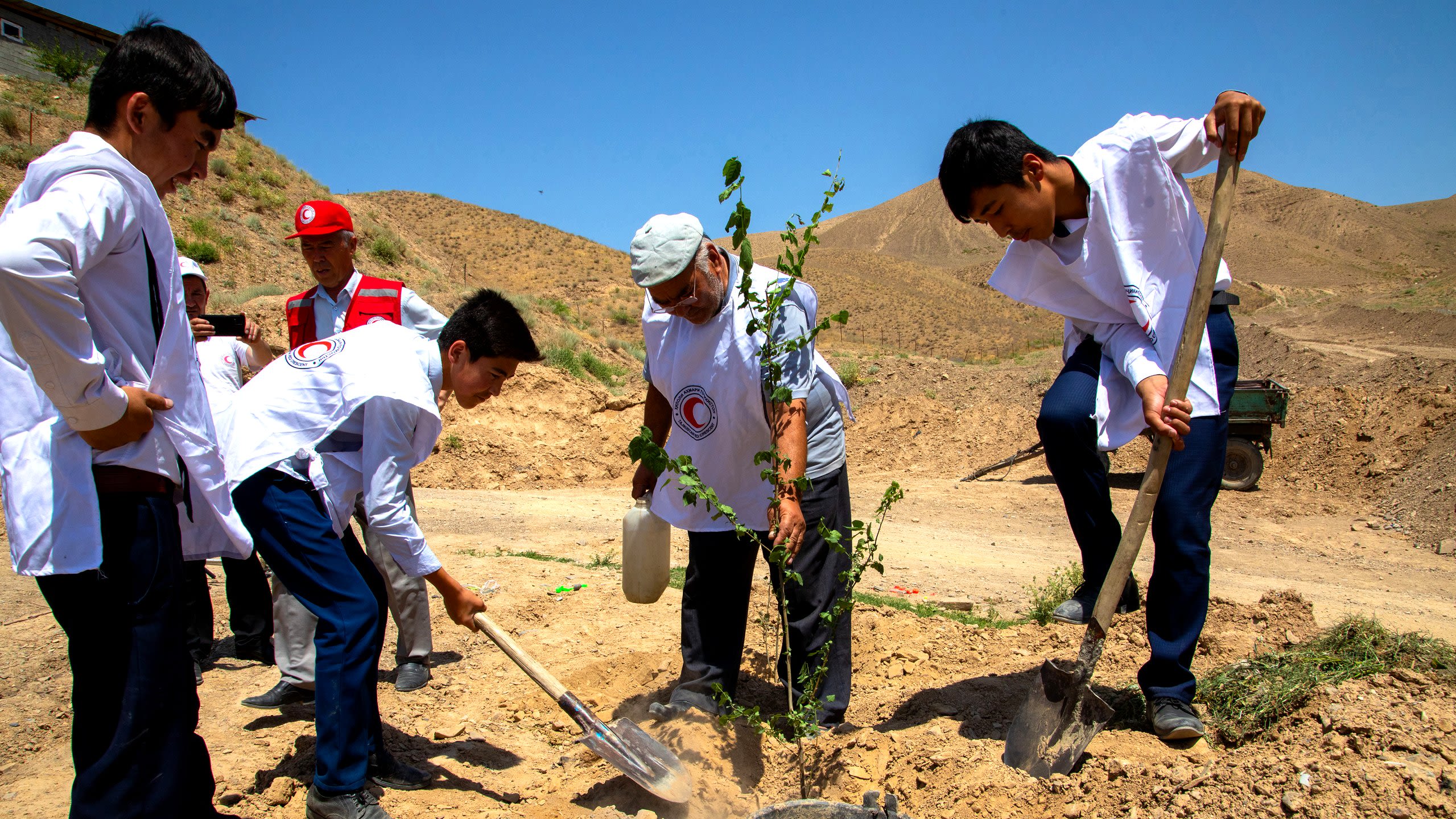
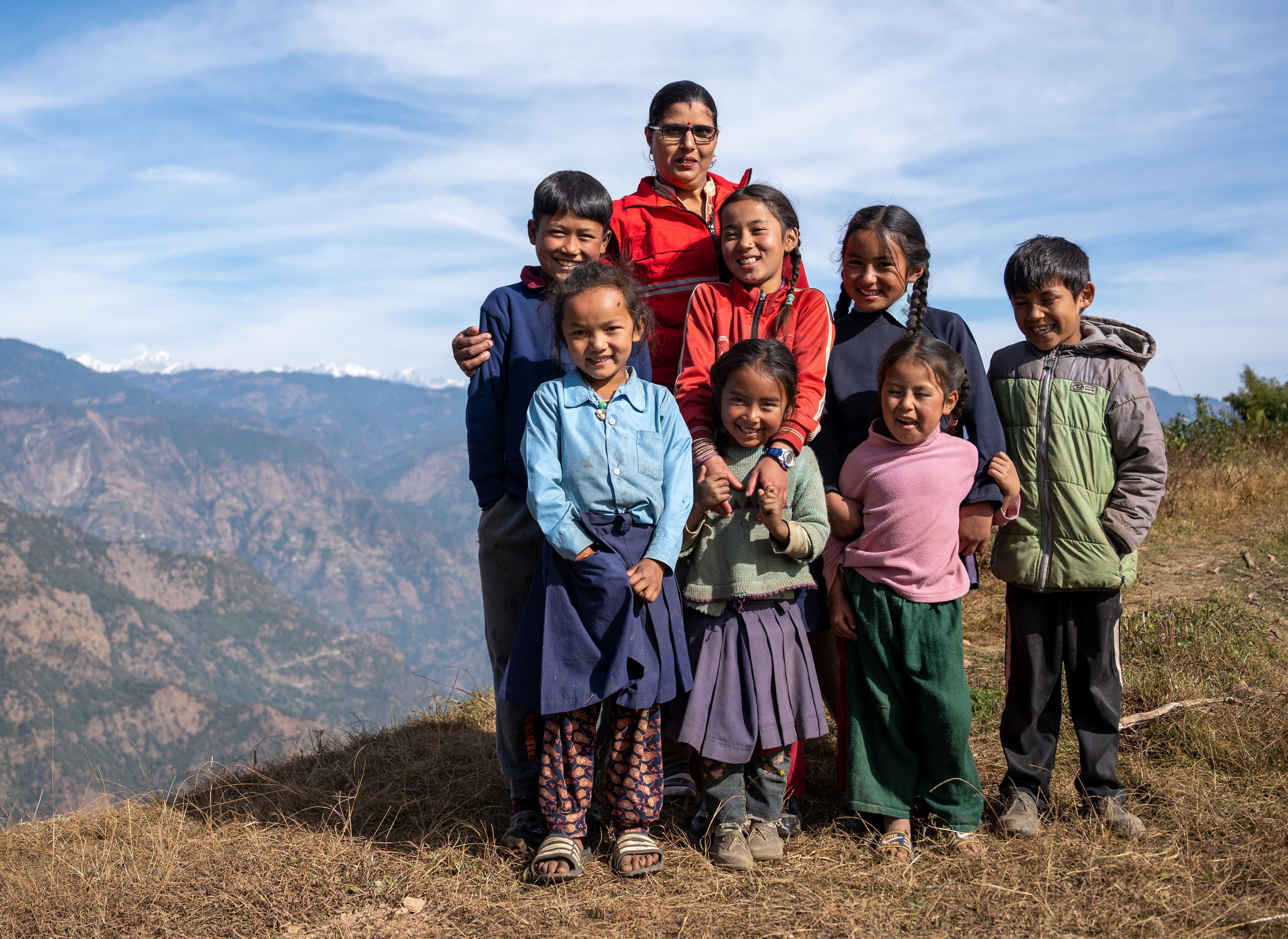
The Nepal Red Cross water and sanitation programme is one of many around the world aimed at the young. WASH is becoming increasingly central to preserving health in a warming world. (IFRC)
The Nepal Red Cross water and sanitation programme is one of many around the world aimed at the young. WASH is becoming increasingly central to preserving health in a warming world. (IFRC)
In 2023, we inspired Red Cross Red Crescent youth and others to take meaningful climate action through increased action, awareness and advocacy.
We advanced the global Red Cross Red Crescent Strategy on Youth-Led Climate Action and launched a mid-term survey, drawing over 500 responses from around the world that will inform work in 2024 and 2025.
We are partnering with the IFRC Limitless Youth Innovation Academy in which millions of young people are expected to be reached. It aims to give them the essential skills and resources to support climate and environmental innovations.
We organized the third Climate and YOUth Summit, with 32 sessions that were attended by 721 people from all over the world. This was a time to connect and be inspired; or, in the words of one of the young participants from Pakistan, “It’s a surreal experience how you organized this, I have felt inspired and connected to all. Totally next-level.”
Our youth advisory group continued to support the network by contributing to climate and mental health work, providing a youth perspective in the climate-screening process, bringing a youth voice to the IFRC Nairobi innovation summit, and strengthening climate education work and youth representation in diverse forums.
We are continuing the successful YAG initiative, adding two new recruits in 2023, and we supported the coordination of IFRC youth delegation at Bonn during the UNFCCC intersessional as well as at COP28.
We provided young people with meaningful opportunities to speak at COP events on education, mental health, social protection and loss and damage. In addition, YAG members were also involved with the design and facilitation of sessions at the youth conference in the run-up to the UN climate talks.
Last year was also the occasion for nurturing youth partnerships, including the Valuing Water Initiative (VWI), the International Union for Conservation of Nature, AquaFed, the KWR Water Research Institute, and contributing to the design of the youth section of the Flood Green Guide of WWF in the US.
VWI, which concluded in December, provided an opportunity to explore further intergenerational approaches, working closely with the Kenya Red Cross through a storytelling workshop. We also created a social media campaign to encourage young people to foster connections with water and reach out to a large audience.
In 2023 we expanded the use of education tools such as Y-Adapt – our interactive curriculum for young people to help them understand climate change and take practical action in their communities. This tool, described as the gold standard of youth climate education by the IFRC, was rolled out in 12 countries in 2023, including the training of new facilitators.
We created new Y-Adapt modules focused on water and reviewed an urban one, and a new mentorship programme has been set up to support young people after completing the modules. The full curriculum has now been translated from English into seven languages.
We supported the Global Disaster Preparedness Centre with the creation of the Teen Prep Kit that features a module on climate change, and we helped develop a climate action curriculum focused on youth leadership in collaboration with the American Red Cross.
For the youngest enthusiasts, we have supported the IFRC and the Cartoon Network in the creation of the Safe Step Kids climate videos and materials for children in the Asia Pacific region.
Our internship programme continues to thrive. In 2023, we worked with 28 interns, from all over the world and they provided us with wonderful support.
Innovation
‘A fantastic opportunity to reimagine humanitarian action’
– IFRC Secretary General Jagan Chapagain, on the
2023 global innovation summit
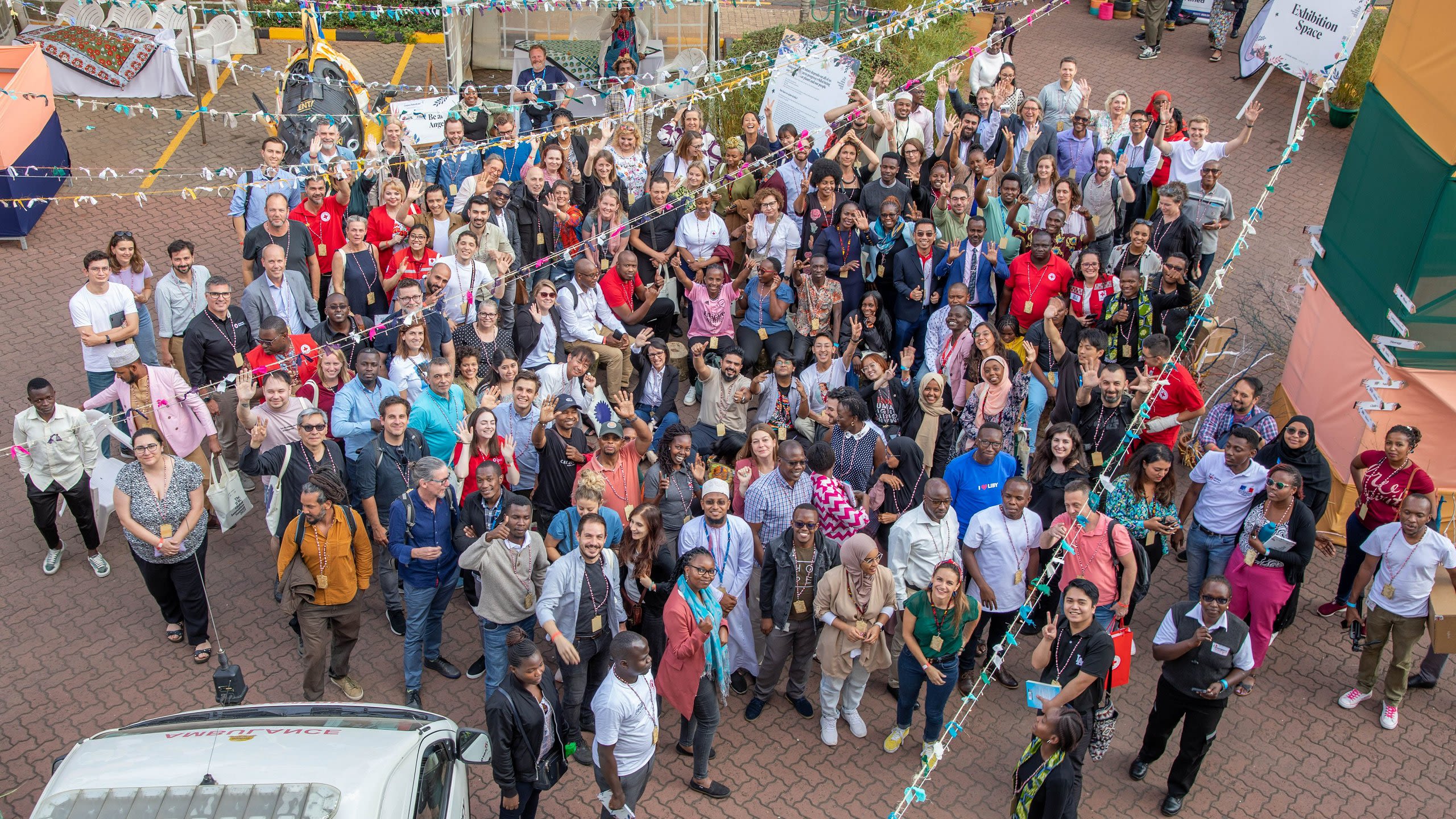
Effective innovation continues to be one of the distinguishing features of the Climate Centre, with partners seeking our contributions both to enrich their endeavours with our tried and tested approaches, and to develop new ways to link climate science, policy and humanitarian practice.
A key platform for our 2023 explorations for innovation was a project entitled Creative Policy Dialogues through Serious Fun: Humour and Acrobatics to Confront Climate and Mental Health. Supported by the Wellcome Policy Lab, we worked with creative collaborators including professional cartoonists and circus artists to enhance engagement, stimulate thinking, connect human cognition and emotion, and accelerate trust and bonding.
We have pursued the unconventional use of cartoons: visual depictions of analogy and metaphor that amusingly communicate complex concepts almost instantaneously. By lightly capturing absurdities, tensions and dangers pertaining to serious matters, we showed humour can reframe thinking, uncover difficult truths, and inspire new ideas.
We developed and deployed nine humorous approaches, including our new Pocket Theatre for Anticipatory Action: a set of short performative vignettes that bring humour to life through unfolding, unrolling and otherwise manipulating the paper on which a cartoon is drawn, opening space for more imaginative conversations.
Similarly, our new pop-up book approach has been enabling difficult discussions. As a well-known medium for communication often associated with children or whimsy, pop-up books can engage audiences with emotional warmth when confronting delicate issues.
With mental health experts, humanitarians and cartoonists, we created a pop-up book that uses three-dimensional pages to offer a simple visualization of complex quantitative information, along with cartoon-style visuals that pop up and move in the hands of a performer to build an emotionally resonant narrative on climate and mental health.
We continued to grow the work harnessing humour for learning and dialogue. Our collaboration with professional cartoonists has now become a celebrated feature of many global and regional events on climate and humanitarian issues, including cartoonathon sessions for the dialogue platform on anticipatory action, the World Bank, the European Development Bank, and many more.
This innovation is also being recognized in academic circles through, for example, a chapter entitled Harnessing humor for tough talks: humanitarian experiences addressing exclusion and climate risks in a book edited by collaborators at the University of California, Santa Cruz.
We also deepened our exploration of risk communication through acrobatics and circus arts involving feats of balance, agility and motor coordination. Acrobatics can resonate with people, including policy-makers, through collaboration, trust, responsibility, creativity, safety and awe.
We developed and built on acrobatics and juggling that can be utilized in presentations, workshops and policy forums. Examples include our performances and workshops at the Global Dialogue Platform on Anticipatory Action and at the Boston Museum of Science with the Circocan International School of Circus from Brazil, as well as our collaboration with CERN Idea Square for a session on risks and policy entitled Gravity Play.
A video entitled Acrobatics and Anticipatory Action, developed in collaboration with professional Australia-based circus artists from Gravity and Other Myths, is an example of how much we can learn from these inspiring experts in managing risk.
The collaborative game Daybreak, which elegantly captures the tough choices confronted by humanity on climate risks, features many of the humanitarian dimensions that emerged during brainstorming and test sessions by the designers, who list the Climate Centre as a partner organization, and was publicly released in October 2023 to critical acclaim.
We have been deepening our exploration of doughnut economics for climate risk and shocks, in collaboration with the economist Kate Raworth and her team. Building on the nature and interaction of four key modes of provisioning, “the state, markets, households, and commons [shareable resources of society or nature],” we are developing a conceptual framework that helps understand, anticipate and address compound risks and cascading shocks.
Through juggling activities that help participants experience the consequences of failure to prepare, we have successfully deployed prototype versions of this approach, including at the ICRC in Geneva and at a London conference on creating effective warnings for all.
In collaboration with the Centre for the Study of Existential Risk at the University of Cambridge, we have continued investigating options on how to prepare for the global climate impacts of the next very large volcanic eruption, as well as ways artificial intelligence may pose a threat while also enabling remarkable new opportunities for linking knowledge with action.

A still from the video Acrobatics and Anticipatory Action, developed in collaboration with Australia-based circus artists from Gravity and Other Myths to illustrate how much we can learn from these inspiring experts in managing risk.
A still from the video Acrobatics and Anticipatory Action, developed in collaboration with Australia-based circus artists from Gravity and Other Myths to illustrate how much we can learn from these inspiring experts in managing risk.
Communications
‘Never before has the Norwegian Red Cross responded to so many simultaneous local emergency incidents’
– Norwegian Red Cross press release after Storm Hans, August 2023
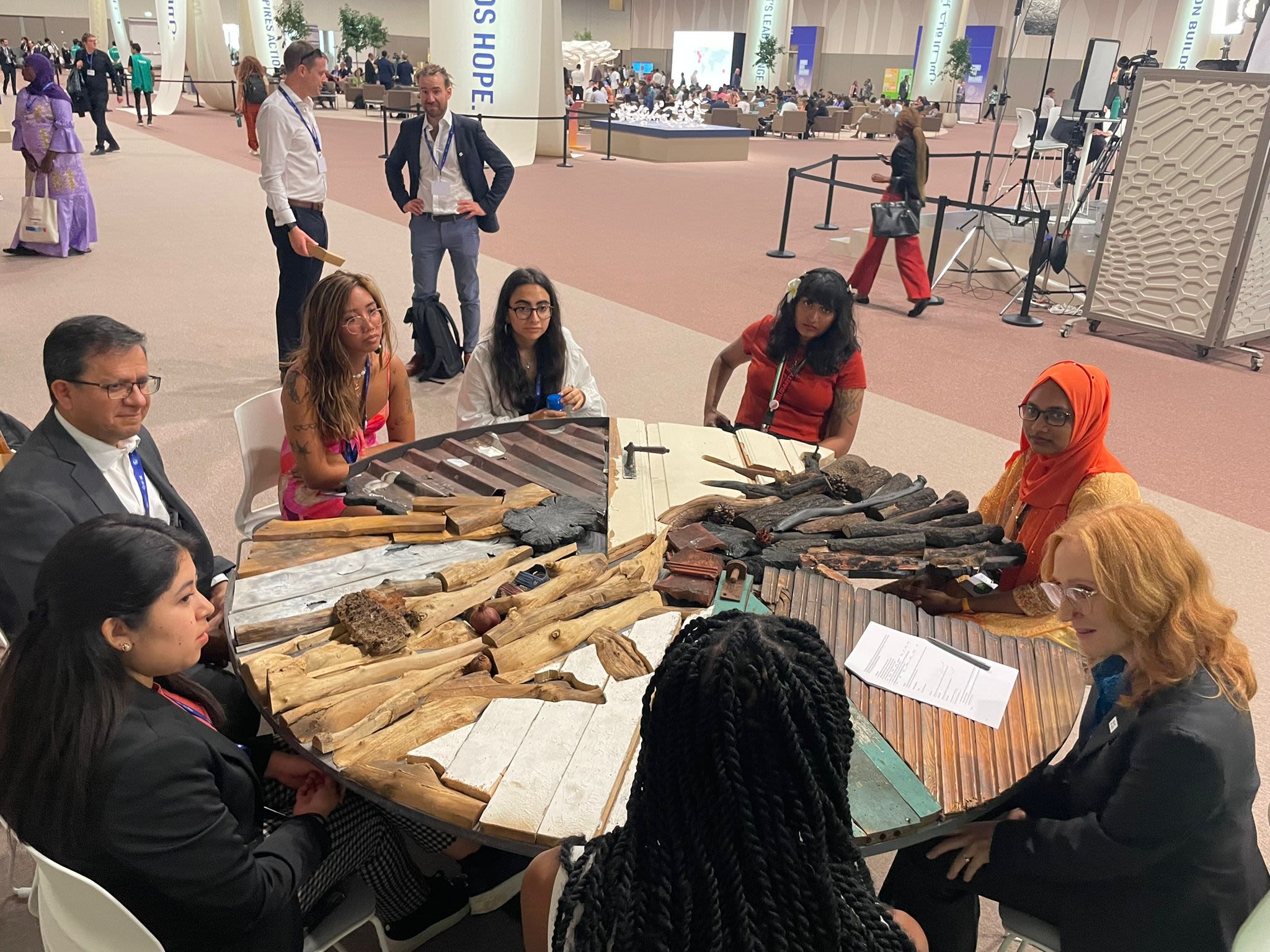
Our acting director Julie Arrighi, science lead Liz Stephens and attribution specialist Roop Singh largely took over from former director Maarten van Aalst as our media contact points. Their engagement in 2023 – again a very busy year for attribution and announced climate-records of many kinds, right from the start – included outlets such as the BBC, France 24, Al Jazeera, Fortune, the (UK) Telegraph, and The New York Times.
Our social media audience continued to grow rapidly in 2023 and we added at least 1,000 new X/Twitter followers over the course of the year, mainly from within the humanitarian, development and climate sector. Our Facebook and LinkedIn feeds continue to use X/Twitter as their main source.
We continued to publish web news stories at the rate of about ten a month, covering all aspects of the humanitarian impacts of climate change, with special reference to the work of National Societies and the Red Cross Red Crescent Movement generally.
The year also saw a complete overhaul of our website in its entirety over a roughly two-month period, intended to make the pages more consistent. The comms desk now doubles as webmaster, which makes for seamless and prompt updating.
Videos from 2023 now available on our Vimeo site include this personal analysis by Julie Arrighi, as part of the IFRC’s Do you have a minute? Series, of the impacts of climate change in urban settings; presentations on anticipatory action in conflict settings; and several acrobatic performances by the Circocan and Gravity and other Myths companies, illustrating connections to issues such as risk and trust.
Early in the year we saw an important success for anticipatory action when farmers in Kenya’s southern Kwale county harvested a variety of crops thanks to an early-action distribution of specialized seeds by the Kenya Red Cross Society: green grams, cowpeas and sorghum, temporarily replacing traditional but more vulnerable maize (lead video).
The Climate Centre promoted this success across all its various platforms: social media, web news and video, deploying its Kampala-based camera operator Denis Onyodi to generate original coverage on behalf of the National Societies involved and the IFRC.
The IFRC and the Climate Centre published a comprehensive new guide to climate-smart programming and humanitarian operations for National Societies. Available in full and summary versions, the guide focuses on how to use climate-related information to reduce risk and human vulnerability.
The Climate Centre assisted the IFRC in publishing a new road map for climate action in the Europe region, framing how the 53 National Societies in Europe and Central Asia will expand climate action over the next few years.
As in previous years, much of our media engagement clustered around the UN climate talks. In what was probably our most significant single contribution to the COP28 meeting, the Climate Centre published a summary of findings on loss and damage from the Working Group II report of the sixth IPCC assessment of the global climate, timed to coincide with the Dubai COP.
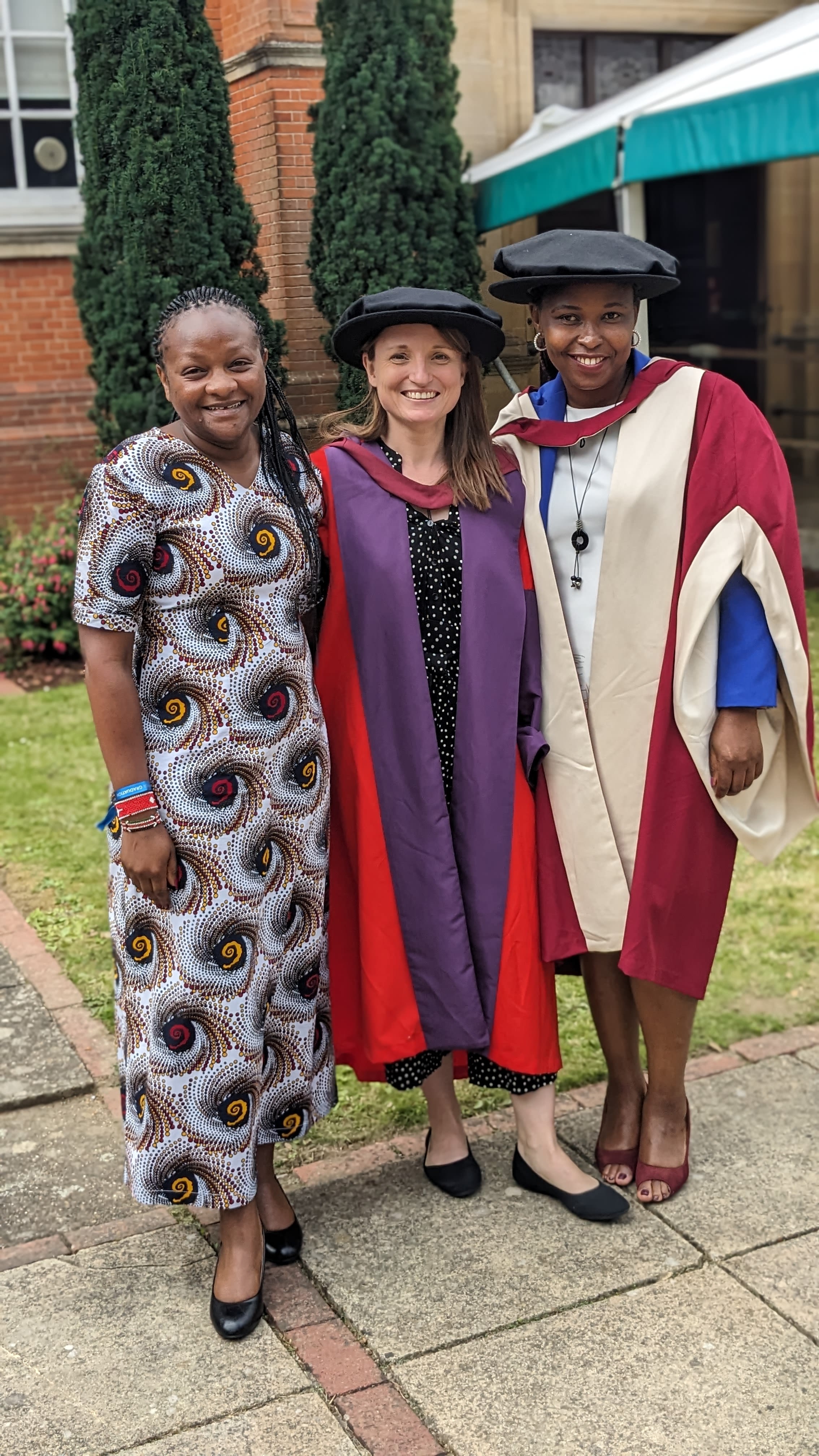
Climate Centre science lead and spokesperson Liz Stephens with colleagues Emmah Mwangi and Faith Mitheu, Kenya Red Cross veterans and Climate Centre consultants. Liz supervised Faith’s PhD (pictured, graduation ceremony) on impact-based flood forecasting in Uganda. (Climate Centre)
Climate Centre science lead and spokesperson Liz Stephens with colleagues Emmah Mwangi and Faith Mitheu, Kenya Red Cross veterans and Climate Centre consultants. Liz supervised Faith’s PhD (pictured, graduation ceremony) on impact-based flood forecasting in Uganda. (Climate Centre)
Starting in March, we handled many queries from both media and National Societies arising from warnings (that turned out to be accurate) of a new El Niño.
A feature story from the ICRC that we cross-promoted showed how in Iraq, Syria and Yemen the effects of climate change are being amplified by the consequences of armed conflict.
One major public event that we both took part in and generated coverage of was the second-ever IFRC global Heat Action Day on 2 June, when Red Cross and Red Crescent volunteers were out and about making sure communities knew how to stay safe during a heatwave, many of them equipped with guidance from the Climate Centre.
Another public event we reported on was the second two-year phase of Italian Red Cross public campaign to raise environmental awareness: Effetto Terra (Earth Effect), including preparedness for extreme weather.
A major exercise in internal Movement communications was the IFRC Global Innovation Summit 2023, described by Secretary General Jagan Chapagain as “a fantastic opportunity to reimagine humanitarian action”, adding that a culture of innovation would enable the Red Cross Red Crescent to address the needs of communities served by the Movement more effectively. A huge variety of workshops over the three days included the Climate Centre’s youth games, facilitated by the MENA youth network.
We produced an episode on nature-based solutions for the Can’t Take the Heat podcast that ended its run in 2023.
Finance
The Climate Centre – an independent foundation under Dutch law – remains grateful to its hosts, the Netherlands Red Cross in The Hague, which also assists with human resources and legal affairs.
We were supported last year by the European Commission, the ICRC and the IFRC secretariat, and these National Societies, in each case with the financial support of their public or governments (alphabetically):
American Red Cross
Belgian Red Cross
British Red Cross
Danish Red Cross
Finnish Red Cross
French Red Cross
German Red Cross
Netherlands Red Cross
Norwegian Red Cross
Swedish Red Cross
Other contributors were (alphabetically):* Bezos Earth Fund, Centre National de la Recherche Scientifique, CGIAR, CICERO Center for International Climate Research, Concern Worldwide, DAI Global, Deltares, European Investment Bank, European Research Executive Agency, FAO, German Bank Foundation, Global Responsibility Austria, Green Climate Fund, Health Canada, Humanitarian OpenStreetMap Team, IKEA Foundation, Institute of Development Studies, Inter-American Development Bank, International Development Research Centre (Canada), International Union for Conservation of Nature, Italian government, Kfw IPEX-Bank, Met Office (UK), MSF Switzerland, Oxford Policy Management, Practical Action, Prudence Foundation, Save the Children International, Science for Africa Foundation, SouthSouthNorth, Swiss embassy Peru, Tetra Tech, UNEP, UNOCHA, Wellcome Trust, WFP, WHO, World Bank, World Wildlife Fund.
We are also grateful for contributions from Bristol, Cape Town and Reading universities, VU (Amsterdam), and the Akademie der Ruhr-Universität. A full financial statement will be available in our hard-copy report later this year.
As always, we thank all our donors for their generous support.
*Some agencies are best known by their acronyms.
